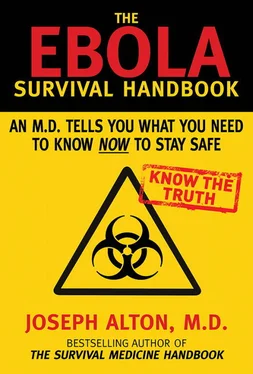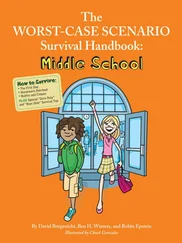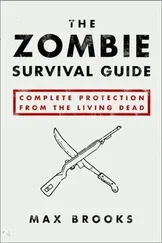Joseph Alton, MD
THE EBOLA SURVIVAL HANDBOOK
This book is dedicated to nurses everywhere (including my lovely wife Amy who is a nurse). Nurses are the heart and soul of medical care, and even as a doctor, I could never achieve for a patient what they can do with a simple touch of their hand and a smile.
INTRODUCTION: An Unexpected Visitor
“TEXAS HEALTH WORKER TESTS POSITIVE FOR EBOLA”
That was the headline that greeted Huffington Post readers via email on a quiet Sunday morning.
This was big news. The medical system of a superpower nation had been trumped by a microscopic organism that looked like a strand of spaghetti. Ebola virus caused a major epidemic in a large region in Africa—all because someone ate bat meat that carried it.
By the end of the week, two nurses who treated Ebola patients in the United States had contracted the disease. These nurses, who were given minimal training in infectious-disease protocols, didn’t just work behind the desk in the emergency room; they worked in an isolation area of an intensive care unit and wore protective gear.
But unlike cases before this, where the disease had been brought to the United States knowingly or unknowingly, these new developments made it clear that Ebola was no longer someone else’s problem—it was now our problem.
The nurses did not contract Ebola deep in the jungle of some third-world country thousands of miles away but in a hospital in Texas. It infected a health-care worker, one of the people on the frontlines of disease control.
These represent the first known cases of transmission of the deadly virus in the United States, but will they be the last? It’s naïve to think so. The commissioner of the Texas Department of State Health Services, Dr. David Lakey, even admitted it in the Huffington Post when he stated, “We knew a second case could be a reality, and we’ve been preparing for this possibility. We are broadening our team in Dallas and working with extreme diligence to prevent further spread.”
Ebola has become a reality to the average American. Of course, it doesn’t always kill. Take the cases of the Americans who were treated, cured, and released back to their families. While their recovery may take a while, and they may never be at 100 percent (Dr. Sacra was readmitted for other reasons soon after his release), they are all still with us. The success has been attributed to good hospital care and access to an experimental drug that had not been previously tested on humans. Dr. Kent Brantley, a missionary with the North Carolina–based Samaritan’s Purse who was evacuated from Liberia on August 2, 2014, said, “I am thrilled to be alive, to be well, and to be reunited with my family. As a medical missionary, I never imagined myself in this position.”
I am also thrilled that Dr. Brantley is alive, but why are people dying from Ebola even though a serum exists that could save them? Why, in view of the dire situation in West Africa, are capable drugs being held back in a quagmire of government bureaucracy? And a bigger question is who decides who will get the drug and who won’t?
It’s not likely that your family doctor will be able to prescribe this medication anytime soon. I wrote this book because it’s important to educate yourself about Ebola and prepare yourself for the small possibility of it coming to your neighborhood. There is no need for panic, but you, the average citizen, should take the time to learn about this deadly disease and how you can prevent it from affecting your family. It all starts with this book.
Ebola is real and the details can be frightening. The World Health Organization currently counts over ten thousand cases and five thousand deaths. If you’re scared, you are not alone. According to a survey taken by Harris Poll/HealthDay, more than two thousand adults polled in the first week of October 2014 (a week before the death of the first US case), 27 percent viewed Ebola as a real threat to health and security. That figure was up from about 13 percent only weeks before. After Thomas Duncan’s death, the numbers skyrocketed. By mid-October, about 55 percent polled believed Ebola was a serious health threat. People have cancelled holiday travel due to fear of Ebola. No infectious disease has generated this much concern since the HIV/AIDS pandemic.
Ebola is a “third-world disease” that is quickly becoming a “first-world disease.” As Mayo Clinic’s infectious diseases physician and researcher Dr. Pritish K. Tosh explains, “Ebola is an agent that evokes a lot of fear, and can result in societal disruption. There’s a reason why it’s considered a possible bioterrorism agent. So any time you have cases in the United States, there is a heightened amount of anxiety.”
Bioterrorism is the weaponization of infectious germs and other agents to kill people and the animals and plants they depend on. Is Ebola a candidate for the next biological weapon? It has been rumored that Ebola is in inventory at high-level labs in many countries, some of which are not our friends.
We are assured that everything is under control. Western methods of taking care of the sick are more advanced; modern equipment is plentiful and available. Hospitals in the United States and other developed countries certainly have more resources than in the third-world countries, but mistakes have been made, and human error could be our downfall.
At the time of this book’s publication, Ebola hemorrhagic fever kills at a 70 percent rate. While this is disturbing enough, the World Health Organization suggests that 1.4 million cases might be chronicled in the following few months.
How is this possible? As health-care workers contract Ebola from patients and bring it to their families, who bring it to people at work or school, who carry it home to their families—it begins a deadly cascade.
If we are complacent, we will see the numbers of American fatalities begin to shoot up. What can we do to prevent such a catastrophe? Of course, there are measures in place, but will enforcers strictly adhere to them? Have we done enough to prevent new cases from being imported from the Ebola zone? Ten thousand West Africans travel to the United States every three months through five major international airports:
• JFK International Airport in New York
• Washington Dulles International in Washington, DC
• O’Hare International in Chicago
• Hartsfield-Jackson International in Georgia
• Newark Liberty International in New Jersey
These airports now perform Ebola screenings for passengers who arrive from the three affected West African nations: Liberia, Sierra Leone, and Guinea. For more than 50 percent of Americans, however, a screening is not enough. The majority would prefer to see a total ban on allowing anyone traveling from those nations into the United States.
With that ban, Thomas Duncan would not have been allowed to come to the United States. He would not have infected the health-care workers who aided him, and this would have saved us millions of dollars in health-care costs and, more importantly, avoided putting American lives at risk.
There will inevitably be economic fallout if people keep getting sick. Hospitalization and treatment of just one Ebola patient takes up an incredible amount of resources. The World Bank recently estimated that, if the disease continued unabated, the economic impact of Ebola could reach $32.6 billion by the end of 2015. What could this mean for the rest of the world? The United States and Spain have already incurred significant costs evacuating their citizens in jets specially modified for infection control. The United States has committed to a large military presence in Liberia, ostensibly on humanitarian grounds. The expense is immense. Will Ebola bankrupt the United States by causing overwhelming financial and resource expenditures?
Читать дальше




![John Stieber - Against the Odds - Survival on the Russian Front 1944-1945 [2nd Edition]](/books/405234/john-stieber-against-the-odds-survival-on-the-russian-front-1944-1945-2nd-edition-thumb.webp)








